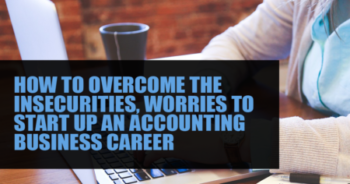How To Start Up An Accounting Business

David: I have a couple of questions and I’m gonna bash these two together, because one question is how do I start advisory services in a certain vertical, whatever that vertical may be. And we had another question that I think’s pretty similar to this which is how would we overcome, if we are worried that we haven’t done this in the past, we’ve already touched on this confidence and what the value will bring. Somebody said, “Well what if I want to sell advisory services, but what if I don’t look the part? Maybe I look younger than these other firms, so how do I start and how do I overcome my worries of being perceived as not as an advisor? Does that mean I have to act and be a certain way? Is it about showing results? Is it about thorough investigation and getting out of my own way and just being very question-driven?” Angie, we’ll start with you on this one. How can they start? Is it talking with clients they know well and gradually getting into a better line of questioning until you’re comfortable in that role? How do you see maybe the first couple of steps people would start doing to go down this advisory path?
Angie: Well first I’ll comment on when I got into consulting, I was 24 years old, female blonde and was dealing with consulting CEOs and Managing Partners that were my parents’ age. So I very, very much dealt with that insecurity of, “Oh my goodness, how in the world am I going to be a consultant to people who know a lot more than I do?” And it was a little bit intimidating for a minute. Somebody gave me some really good advice immediately and said, “You’re not telling them what they know. You are not consulting around what they know, you are helping them uncover solutions and sharing what you know.” So I would start with that and just say, “Anybody can serve as an advisor if you are careful in your approach.”
And in terms of the second part of your question, again I think it comes down to being curious. I think it comes down to asking questions about the business and the needs.
For example, you might conduct what we call a client spotlight meeting. So if you have a client, ABC Client, maybe you pull together somebody from tax and audit and other service lines and maybe somebody in your firm that has done work within a specific industry and you start taking a look at the client. What kinds of services have we provided? What is going on in their industry and the market? What are some of the challenges? What have they used us for? What haven’t they used us for? Who are their attorneys? Who are their bankers? Who are their suppliers? And you really do an analysis before you even involve the client, where you can do some background press.
Then you’re more equipped when you meet with the client to ask what we call high gain or high impact questions around the business. And that will uncover additional needs in certain areas. So it could be, again, that there are certain services that you provide. Maybe it’s around R&D tax credits, maybe it’s cost segregation, maybe it’s more entrepreneurial consulting. I love Steve’s definition of what it means to be an advisor in terms of using the data. I just think that’s brilliant. So again, do your research, come up with a list of questions, meet with the client, talk about what the needs are, regroup back with your team and determine how can we help them through the services that we currently offer. And if we don’t offer something that can help, how can we create maybe an advisory board with other trusted advisors that we work with where we can be more of an advisor to this client.
David: Perfect, yeah I love that approach and we got a lot of people asking about various tools and apps and things like that. We’re gonna ask that question but I want to say it’s so important to get the mindset right, and so important to get some of the methodology in place because the tools can accelerate whatever already there, the mindset, the method. And so we definitely want to focus in on that and we’re gonna get to some of the tools here in a little bit. Believe me I can geek out on tools with the rest of them, we do so all the time at Jetpack, we look at everything else.
But what’s great about what you guys are saying is that there’s so much power in what a firm is doing and sitting down, I’m just writing a bunch of notes here, thinking how this process could work, is looking at a client file, looking at the profit margin, looking at the revenue growth, looking at different expense levers or different things that they might be looking at and then comparing that against benchmark reports. You could say, “My goodness, they have a highly profitable, or they’re actually almost half of what a typical profitable business in this area’s doing,” and then you can begin doing some investigating what is the case. That’s incredibly valuable ’cause the business owner’s not gonna dig into it that much and to both your points, we take for granted some of the knowledge we know and then using the data to lead to uncovering problems and solutions. You know Steve, when somebody comes to you and one, they have this moment where they might say, “I think I’m too young to maybe go into advisory services, or I’m gonna be perceived as too young or too inexperienced and also how do I even start that conversation,” what’s your reaction to that approach and how can somebody overcome maybe some of those obstacles?
Steve: Angie was absolutely spot on with everything that she said in her answer to this question and it’s really interesting. We have 22 year old twins and on Friday the twins will be sending to the printer their first ever business book and it’s 220 pages long and it’s got some awesome reviews already. It’s called Better Business, Better Life, Better World. I’m not trying to sell it, it’s not gonna probably be even available in the States. But the point is if 200 new graduates can write a business book, there’s a lesson in there for each of us. In fact, when I started my accounting practice, and my background was that I trained with KPMG in the UK and then left them to set up my own accounting firm. Now the contrast between running a little accounting firm from a spare bedroom at home, which is what I found myself doing, and being an audit manager in one of the world’s largest accounting firms, was enormous and I didn’t want to do audit work in my new accounting firm. This is many years ago, this is when I was about, just under 30. I’m 55 now. So what I decided to do was I wrote a book. My first book is actually this one here. It’s called 101 Ways to Make More Profits. It was published over 20 years ago. I wrote that book rather than having a brochure, I wrote that book because what it would do instantly in the eyes of my prospects and my clients was establish credibility. I was still a relatively young accountant. I was certainly a brand new practitioner, I’d only been in a large firm. I was not trying to win small clients and I didn’t want to do the only thing I was actually trained for which was audits. So I sat down and wrote my first book and amazingly, back in those days, back in the 90s, you actually needed a publisher and I got a publisher, Kogan Page. It was fantastic, they translated into 14 languages and sold all around the world.
However, the process of writing that book was so much easier than people dare to imagine. All of my books, and I’ve written seven or eight now over the years, have all followed the same format and I would encourage everybody listening to this to consider writing their own book in order to establish credibility, because without credibility in the eyes, both with your existing clients because there’s track record of doing perhaps relatively ordinary client stuff, and with new prospects there’s a skepticism and cynicism about yet another accountant claiming to be an advisor. You have to be able to prove those claims rather than merely make those claims. And there is nothing better at establishing your credibility rather than two base things. Number one, having something published and number two, standing up on stage and talking about your ideas in a confident way. But if we stick with the book idea for now, this first book was 127 pages long and it’s called 101 Ways to Make More Profits. So you can already work out the math. Each of those ways is about one page long. All I had to do in order to write that book, was have 15, 20, 30 minutes at a time, over a several month period, to write one way, to come up with one idea. It didn’t have to be 127 pages of joined up thinking. It was 127 pages of little bite-sized chunks of thinking which we were all around the theme of, in this case, improving profits or improving your business, or whatever. That’s a really easy approach to writing a book. Back in those days, you needed a publisher. Today you don’t. You can independently publish. They call it self-published. They call it independently published, I.e. you do it yourself. You can list it on Amazon. You can get it printed for a few quid. The crucial thing is that you have that book because then you can gift it to people when you first meet a prospect or when you are talking to clients, or when you’re explaining that you’ve refocused the firm on more valuable services. “One of the things that we’ve done as part of that is we’ve drawn together, and it’s just some of the insights that we gained over the last 20 years of working with businesses, just like yours, Dave, and we’ve written this book.” And suddenly credibility is just instantly established.
The other thing about a book is you don’t need a publisher, there’s nothing formal defining how long a book needs to be or whatever format it’s in so it’s remarkably easy and it’s incredibly powerful. So the first thing I would do to establish credibility, whatever age you are, is to write stuff. Yes, you can write blogs and they’re great, you can use LinkedIn to post facility, and that’s a great vehicle to do that but there is nothing more valuable, I think, nothing better as a way of establishing your credibility than actually writing your book and having it published in hardback form. In fact, all of my books now are published in hardback only because there is so much more credibility than a paperback as the first one was. So that’s the first thing I would do. I would also get comfortable with speaking in public because you can massively establish credibility and therefore overcome all of that skepticism if you are able to stand up on a stage and talk for 15 minutes, 30 minutes, 45 minutes around interesting, valuable, powerful stuff.
You also need, third thing I think you need, is to collect case studies, collect stories of the differences you have made because the issue we’re talking about here is credibility and the best way of establishing, one of the best ways of establishing credibility is to point them to and be able to talk about things you have already done, the difference you have already made to other clients. If you can name those clients, great, but if you can’t, if you don’t have their permission to tell those stories, you can always anonymity the story, change the name, change the location, change the business sector so there’s no way anybody can identify what that case study is.
But the point is, tell the stories. Tell those stories. Systematically capture and tell those stories about the difference that you’ve made to other people’s profitability, to their turnover, to their work life balance, to the value of their business, to the size of their order book, to their systems, to their efficiency productivity costs or whatever, and use those stories. Then to provide compelling proof to other clients and prospects that you really can help, that you really can make a difference rather than simply keeping the score of stuff that’s already happened. The third thing you need … the other thing you need I think are tangible. I book is a great example of a tangible because it exists, it’s real. You can give it to them, you can show it to them, it’s with them long after you’ve gone. Whereas words, the things you say, are vibrations in the air and they’ve gone straight away. So you need some tangible and I’m not talking about brochures, ’cause they’re just fluff, aren’t they? They’re marketing fluff. You need some physical tangible that really prove that you do stuff that’s different so one of the main, one of the best deliverables, which is also a great tangible to illustrate, is to be in a position where you can benchmark their business compared to others in their industry. I would suggest keeping that benchmarking analysis as simple, as uncluttered as possible. So we help accountants here in the UK present their benchmarking findings across 19 or 20 key metrics on a single A4 piece of paper, landscape on a single piece of paper. [crosstalk 00:12:40]
David: I’ll just jump in for two seconds here, because we had a couple of questions on this and this might be a good time. So I’ll just ask you a small follow-up and I want Angie’s opinion here as well, which is somebody said what do you and just as a [inaudible 00:12:57] at Jetpack we’re not endorsing one advisory app over another, so we’ll just spotlight whichever one makes sense but do you recommend a certain tool, have you seen one that works well out in the marketplace, and then obviously Angie I want your opinion [inaudible 00:13:12] all of the firms that you work with as well here.
Steve: Well my experience is predominantly here in the UK because it’s UK accountants that I mostly support and serve and here in the UK there wasn’t, there haven’t historically been many consulting advisory tools. That is beginning to change now, globally with cloud-based apps and zero plug-ins and so on. I hear great things about Spotlight, I hear great things about CrunchBoard, I hear good things, really good things about Panalytics, for example. Profitsense, I’m sure there are lots of others. In the UK we’ve created our tools for UK accountants to benchmark, for example and to do profit sensitivity calculations and so on and so forth, so there are an increasing number of great tools out there but I’m sure Angie has better US experience than I do.
Related Articles:





